Not many know or have heard about the large crater in Lonar Crater Lake. Madhu’s dad, who is a retired scientist and very interested in such stuff, didn’t know about it either; he was quite surprised that something this important is not public knowledge! Moreover, it is not really considered to be a tourist destination as it is out in the boondoggles, somewhere in central Maharashtra. The only reason it made it to our list was because it was mentioned in the guidebooks and seemed to be doable as a day-trip from either Aurangabad, which was definitely part of our itinerary, or Jalna, where Madhu’s cousin lived.
Our friend and someone who has offered us plenty of valuable travel advice, being a travel buff himself, Soumya, visited Lonar Crater Lake last August and had had a great experience touring it. He was guided around the area by a local guide, GAM. Soumya recommended GAM to us and provided us with his number. So we sought GAM out and told him of our plans to visit Lonar Crater Lake on Saturday. He said that his tour starts at 6:30am, sharp, in the morning and usually lasts for about 3 to 4 hours depending on our interest level. For this he charges Rs.900. We thought this was a tad too expensive but since he came highly recommended, we didn’t think twice before agreeing on seeing him at 6:30am in Lonar on Saturday morning.
After touring Ajanta, we stayed Thursday night at Madhu’s cousin’s home in Jalna. Being a complete sweetheart, he offered us his car and a driver to drop us off at Lonar the next day. We had initially planned on taking a State Transport bus but the lure of an air-conditioned, comfortable ride proved to be too tempting . So on Friday morning, after breakfast, we took his car and headed off to Lonar. Online, we had found a MTDC ‘resort’ listed as the only accommodation available close to the crater. The other lodges sounded a little too basic plus they were all within Lonar village from where getting to the crater early in the morning would have been a pain. So we had no options but to pick the MTDC place. We checked in around 1pm, ate lunch at their onsite restaurant and then retired to our room for a brief siesta.
The crater in Lonar is said to have been created by a meteorite impact nearly 52,000 years ago, 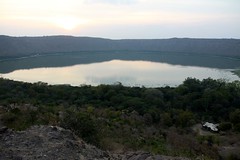 thereby forming the world’s largest hypervelocity, meteoritic impact crater in basalt rock. A lake in the center of the crater is both saline and alkaline in nature. In fact, it is highly alkaline with pH levels at 10.7. Today the water is just about 25feet deep because of the silt that is accumulating at the bottom. It is believed that the meteorite is still buried deep in the crater and it is this belief that has brought a lot of scientists from across the world, including some from NASA, to Lonar Crater Lake. The crater-lake ecosystem has also been a topic of various studies. It is not just the scenic beauty of the place that attracts non-research-oriented visitors like us, but also some curiosity that surrounds such a phenomenon.
thereby forming the world’s largest hypervelocity, meteoritic impact crater in basalt rock. A lake in the center of the crater is both saline and alkaline in nature. In fact, it is highly alkaline with pH levels at 10.7. Today the water is just about 25feet deep because of the silt that is accumulating at the bottom. It is believed that the meteorite is still buried deep in the crater and it is this belief that has brought a lot of scientists from across the world, including some from NASA, to Lonar Crater Lake. The crater-lake ecosystem has also been a topic of various studies. It is not just the scenic beauty of the place that attracts non-research-oriented visitors like us, but also some curiosity that surrounds such a phenomenon.
In the evening, around 5pm, after some tea, we walked to the crater, which is just across  the road from the hotel. A narrow, well-trodden, dirt path scattered with rocks, seemed to lead down to the lake and we followed it to about mid-way. By then the sun started to set and we knew it would be dark by the time we got to the bottom; it would be silly to attempt climbing back up in the dark. So we stopped, found a rock to rest our butts on and sat gazing out into the wonderful scenery. We could see many temples or at least ruins of them scattered around the periphery of the lake. We also spotted some 8 to 10 peahens and a couple of peacocks strutting in a line across the temple courtyard – it was an exciting discovery ! In the pictures that we had seen of the crater, the vegetation had looked lush green and dense. However, now it seemed a little dry and sparse. We realized that visiting Lonar during or just after the rains would have been nicer. As we sat enjoying the peace, we saw many local folk working their way back up the rim. Amongst them were some youth who seemed to be training for a marathon. Later, one of the guys told us that apart from the marathon, they were also training for selection to the police academy.
the road from the hotel. A narrow, well-trodden, dirt path scattered with rocks, seemed to lead down to the lake and we followed it to about mid-way. By then the sun started to set and we knew it would be dark by the time we got to the bottom; it would be silly to attempt climbing back up in the dark. So we stopped, found a rock to rest our butts on and sat gazing out into the wonderful scenery. We could see many temples or at least ruins of them scattered around the periphery of the lake. We also spotted some 8 to 10 peahens and a couple of peacocks strutting in a line across the temple courtyard – it was an exciting discovery ! In the pictures that we had seen of the crater, the vegetation had looked lush green and dense. However, now it seemed a little dry and sparse. We realized that visiting Lonar during or just after the rains would have been nicer. As we sat enjoying the peace, we saw many local folk working their way back up the rim. Amongst them were some youth who seemed to be training for a marathon. Later, one of the guys told us that apart from the marathon, they were also training for selection to the police academy.
On Saturday morning we woke up early, ordered an early breakfast and were ready and raring to go by 6:30am. But there was no sign of GAM. When we called him he said he was on his way and would be there in about 10 to 15 minutes. I hate being made to wait especially since we had painstakingly woken up quite early for this tour! GAM eventually showed up just after 7am. He was a young chap, probably in his mid to late twenties. He flashed us a wide smile and shook hands with Madhu. I was surprised to see that he didn’t bother apologizing or even acknowledging that he was late. Even though it was a petty thing, his nonchalant attitude bothered me and immediately made me sulk . Sadly, the tour that I had great expectations from, started off on a not-so-nice note.
GAM walked us across the street to a point on the crater rim where the Geological Survey of 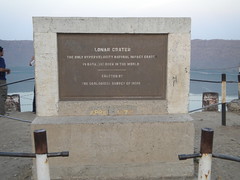 India had put up a sign stating the place to be ‘The only hypervelocity natural impact crater in basaltic rock in the world’. He told us about its creation and about the various international science bodies that are interested in understanding the rock formations and ecosystem of the crater. He told us quite a bit about himself too. He is a local Lonar boy, having been born and raised here. He got accredited by the govt to be an official guide of the crater at the tender age of 18 and has been guiding both tourists as well as scientists ever since. He has worked closely with the NASA team that comes to Lonar annually and has been encouraged to film a documentary on the place and write a book on it as well. All this sounded fantastic and some of my anger melted away as I realized that it was truly commendable for a boy from rural India to achieve so much at such a young age.
India had put up a sign stating the place to be ‘The only hypervelocity natural impact crater in basaltic rock in the world’. He told us about its creation and about the various international science bodies that are interested in understanding the rock formations and ecosystem of the crater. He told us quite a bit about himself too. He is a local Lonar boy, having been born and raised here. He got accredited by the govt to be an official guide of the crater at the tender age of 18 and has been guiding both tourists as well as scientists ever since. He has worked closely with the NASA team that comes to Lonar annually and has been encouraged to film a documentary on the place and write a book on it as well. All this sounded fantastic and some of my anger melted away as I realized that it was truly commendable for a boy from rural India to achieve so much at such a young age.
Roughly hewn stone steps led us from the rim of the crater to its base. From the top, it seemed like a 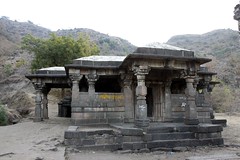 long, steep descent but it wasn’t all that bad. We were at the base within a few minutes and found a temple near the bottom of the steps. GAM claims that there are, in total, 22 temples within the crater and its rim. He showed us inside four temples, which were pretty much in ruins with collapsed roofs and thick vegetation around them. They were all built of basaltic rock. One was dedicated to Lord Shiva, one to both Lord Shiva as well as Ganesh (this was the most dilapidated one), the other to Lord Murugan while the fourth was dedicated to Lord Rama. All four had lovely carvings on the doorframe to the inner sanctums. Lord Rama’s temple was the most well-preserved and is still used by the locals. Inside, GAM showed us how 7 shadows are formed by the human body when they stand in front of the deity close to the inner sanctum. He also placed a couple of compasses on the floor of the temple to show us the strange magnetic field in the area. Both compasses showed opposite directions and when they were moved along the floor of the temple, the needle swung around in circles incessantly – it was quite fascinating!
long, steep descent but it wasn’t all that bad. We were at the base within a few minutes and found a temple near the bottom of the steps. GAM claims that there are, in total, 22 temples within the crater and its rim. He showed us inside four temples, which were pretty much in ruins with collapsed roofs and thick vegetation around them. They were all built of basaltic rock. One was dedicated to Lord Shiva, one to both Lord Shiva as well as Ganesh (this was the most dilapidated one), the other to Lord Murugan while the fourth was dedicated to Lord Rama. All four had lovely carvings on the doorframe to the inner sanctums. Lord Rama’s temple was the most well-preserved and is still used by the locals. Inside, GAM showed us how 7 shadows are formed by the human body when they stand in front of the deity close to the inner sanctum. He also placed a couple of compasses on the floor of the temple to show us the strange magnetic field in the area. Both compasses showed opposite directions and when they were moved along the floor of the temple, the needle swung around in circles incessantly – it was quite fascinating!
As we walked towards the lake, we spotted some peacocks in the thick of vegetation.  At the lakeshore there were hundreds of birds and the scenery was absolutely gorgeous! Here GAM dipped a pH strip into the water and it turned dark bluish-violet, proving that the water is highly alkaline. We were expecting to walk around the perimeter of the lake but GAM suggested that we walk thru some fields that have been cultivated at the base of the crater by the locals and hike back up the rim to more temples. This suited us just as well, so we followed him as he walked north. It was surprising to know that locals actually lived here at the base of the crater and cultivated fields. We walked past some fantastic banana plantations and chomped on tamarind on the way .
At the lakeshore there were hundreds of birds and the scenery was absolutely gorgeous! Here GAM dipped a pH strip into the water and it turned dark bluish-violet, proving that the water is highly alkaline. We were expecting to walk around the perimeter of the lake but GAM suggested that we walk thru some fields that have been cultivated at the base of the crater by the locals and hike back up the rim to more temples. This suited us just as well, so we followed him as he walked north. It was surprising to know that locals actually lived here at the base of the crater and cultivated fields. We walked past some fantastic banana plantations and chomped on tamarind on the way .
I was dreading the hike up in the morning sun but it wasn’t all that bad especially since we kept stopping every few minutes to take pictures and enjoy the lovely landscape. En route GAM kept us regaled 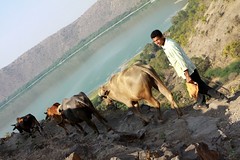 with stories of his exploits and achievements . He claimed to be an ‘expert’ photographer, which was a little hard to digest given that he was carrying the same model of point-and-shoot camera as mine . He joked quite a bit and behaved as though we were his long lost pals. We realized that he was giving us more insights into his own life than about the crater, which wasn’t what he was being paid to do . But we held our patience and kept going. We passed a local person carrying a large, empty basket heading to the base of the crater. Within a few minutes while we were sitting around catching our breath, he returned back up with the basket filled with green bananas. Apparently he is paid for transporting them to the rim where they can be sold by the villagers. It was amazing how easily he seemed to be climbing up and down the rim. He said that he makes at least 7 round trips a day depending on the number of bananas that need to be transported. We also passed a herd of cows and buffaloes being led down to the base – not sure why, though!
with stories of his exploits and achievements . He claimed to be an ‘expert’ photographer, which was a little hard to digest given that he was carrying the same model of point-and-shoot camera as mine . He joked quite a bit and behaved as though we were his long lost pals. We realized that he was giving us more insights into his own life than about the crater, which wasn’t what he was being paid to do . But we held our patience and kept going. We passed a local person carrying a large, empty basket heading to the base of the crater. Within a few minutes while we were sitting around catching our breath, he returned back up with the basket filled with green bananas. Apparently he is paid for transporting them to the rim where they can be sold by the villagers. It was amazing how easily he seemed to be climbing up and down the rim. He said that he makes at least 7 round trips a day depending on the number of bananas that need to be transported. We also passed a herd of cows and buffaloes being led down to the base – not sure why, though!
At the northern end of the rim is a fantastic 12th century temple dedicated to Lord Vishnu. 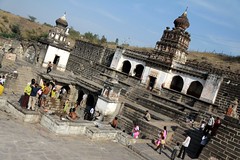 We had to scramble across rocky ledges and narrow dirt paths to get to it but it was totally worth the effort. A small water tank sat in front of the temple and here men and women bathed under a spout that protruded from the back wall of the tank. Apparently, nobody knows the source of this water but it is a perennial one with the force of water lessening just a little bit during the dry months. We sat on the steps of the tank and watched the humanity around us for a few minutes. Men and children washed themselves clad only in their underwear while women bathed fully clothed in saris .
We had to scramble across rocky ledges and narrow dirt paths to get to it but it was totally worth the effort. A small water tank sat in front of the temple and here men and women bathed under a spout that protruded from the back wall of the tank. Apparently, nobody knows the source of this water but it is a perennial one with the force of water lessening just a little bit during the dry months. We sat on the steps of the tank and watched the humanity around us for a few minutes. Men and children washed themselves clad only in their underwear while women bathed fully clothed in saris .
We exited the temple from its rear entrance which led out to the village streets of Lonar. GAM showed us his home on the way and then treated us to tea and piping hot pakoras at a nearby tea-stall. From here we walked thru the village to our last stop of the day – a fabulous 10th century, Khajuraho-style Daityasudan temple, again dedicated to Lord Vishnu. On the way, we were joined by young Faizal who GAM claimed to be his understudy. Faizal hopes to be a Lonar guide like GAM someday and therefore tags along with him, whenever possible, to learn the trade. Unfortunately, GAM’s egoistic attitude took on a higher level with Faizal around, trying to show off his knowledge and confidence. Faizal’s lack of conversational skills, especially in English, made him the butt of more jokes and sarcasm. I immediately felt bad for the smiling, timid chap who seemed to be used to such tirade. Sad!
The gorgeous Daityasudan temple sits in the middle of a large stone courtyard and is 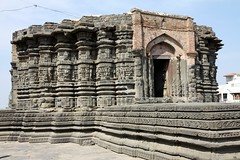 missing a shikhara. GAM informed us that to preserve it from the rampaging Mughal forces, locals covered the entire temple in mud building a small hillock in the process. The temple was excavated out of the hill only in the 19th century and has since been used regularly by the locals. The carvings on the outer walls of the temple were exquisite and quite reminiscent of the ones we saw in Khajuraho. Inside, the Antara (passageway between the sabha mandap and inner sanctum) had exquisite carvings in the four corners of the ceiling. I especially loved one of Lord Krishna playing his flute and dancing. There are no lights within the temple, so GAM showed us all of this with his torchlight. The idol of Lord Vishnu was placed in the inner sanctum in the 19th century and is not the original one, which seems to have been plundered.
missing a shikhara. GAM informed us that to preserve it from the rampaging Mughal forces, locals covered the entire temple in mud building a small hillock in the process. The temple was excavated out of the hill only in the 19th century and has since been used regularly by the locals. The carvings on the outer walls of the temple were exquisite and quite reminiscent of the ones we saw in Khajuraho. Inside, the Antara (passageway between the sabha mandap and inner sanctum) had exquisite carvings in the four corners of the ceiling. I especially loved one of Lord Krishna playing his flute and dancing. There are no lights within the temple, so GAM showed us all of this with his torchlight. The idol of Lord Vishnu was placed in the inner sanctum in the 19th century and is not the original one, which seems to have been plundered.
It was almost 11am by the time we finished touring the temple. From here we took an auto back to the MTDC resort accompanied by both GAM and Faizal. Madhu’s cousin had sent his car again to pick us up and it was scheduled to be at the resort by noon. So we packed our bags and waited for it at the MTDC restaurant. GAM used the opportunity to talk more about himself and his popularity. By this time we had had enough of his talks and had started looking forward to his leaving. I was afraid he would hang around right until noon but thankfully he left soon. We reluctantly paid him Rs.900 and watched him walk across the road back to the village with an arm around Faizal’s shoulder.
Overall, it hadn’t been as great a tour as we had expected it to be. GAM definitely knows his stuff but, unfortunately, his popularity as an ‘expert Lonar guide’ seems to have gone to his head. If he had just concentrated on the crater instead of his own self it would have been a far more rewarding experience. Moreover, the little information he gave us didn’t seem worth the Rs.900 that he charges. It would have been cheaper to just have a local boy show us the paths around the crater and its temples. Towards the end, his overbearing attitude with Faizal made things worse and we really didn’t enjoy the Daityasudan temple as much as we should have.
We got back to Jalna around 3pm. En route we stopped at a small, family-run dhaba for food and it was absolutely wonderful. Today Madhu’s cousin took us to Aurangabad for some shopping where I shopped for a couple of Kurthis as well. Tomorrow we plan to take a train to Nasik, our next, and probably the last, stop in Maharashtra.


Very well written and descriptive report. You should add this to indiamike too.
Thanks, Snonymous … Not sure if the mods would have issues with posting articles on the board.